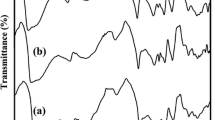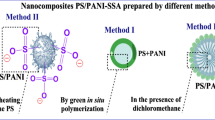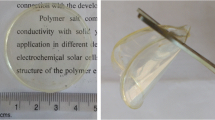Abstract
Dielectric as well as electrical conductivity studies for polystyrene blended with polyaniline (PS/PANI) prepared by a casting method. These investigations indicated that PS/PANI 10% blend is found to possess the optimum electrical properties. For such reason, it was chosen to be blended with various contents of polyionic liquid (PIL) and carrying out further investigations in addition to the dielectric and electrical conductivity measurements. The mechanical, morphology, as well as thermal stability studies, indicates that PIL can act as a compatibilizer to PS/PANI blends. An increase in thermal stability as a result of the presence of PIL was detected by the thermogravimetric analysis. To increase the electrical conductivity of PS, two steps were done. The first step is blending PS with polyaniline (PANI). This step led to the conclusion that PS/PANI with concentration 10% PANI possess the optimum electrical properties as the values of σ increase by increasing PANI content in the PS/PANI blends, but it is still in the range (10–10 S cm−1). This finding recommends such composites to be used for the anti-static applications. For higher performance, the second step was done by choosing such optimum PS/PANI blend to be blended with polyionic liquid. It is of great interest to find that the values of σ dc increase two decants to be in the order of 10–8 S cm−1 which are highly recommended to be used for electrostatic dissipation applications.






Similar content being viewed by others
References
Matsumoto H, Sakaebe H, Tatsumi K, Kikuta M, Ishiko E, Kono M (2006) Fast cycling of Li/LiCoO2 cell with low-viscosity ionic liquids based on bis (fluorosulfonyl) imide [FSI]−. J Power Sources 160:1308–1313
Gorlov M, Kloo L (2008) Ionic liquid electrolytes for dye-sensitized solar cells. Dalton Trans 20:2655–2666
Endres F, El Abedin SZ (2006) Air and water stable ionic liquids in physical chemistryPhys. Chem Chem Phys Phys Chem Chem Phys 8(18):2101–2116
Yuan J, Antonietti M (2011) Poly(ionic liquid)s: polymers expanding classical property profiles. Polymer 52:1469e1482
Rozik N, Antonietti M, Yuan J, Tauer K (2013) Polymerized ionic liquid as stabilizer in aqueous emulsion polymerization enables a hydrophilic-hydrophobic transition during film formation. Macromol Rapid Commun 34:665–671
Kaniappan K, Latha S (2011) Certain investigations on the formulation and characterization of polystyrene/poly(methyl methacrylate) blends. Int J Chem Tech Res 3:708–715
Sengwa RJ, Choudhary S (2014) Dielectric properties and fluctuating relaxation processes of poly(methyl methacrylate) based polymeric nanocomposite electrolytes. J Phys Chem Solids 75:765–774
Gray FM (1991) Fundamentals of technological applications. Wiley–VCH, UK, pp 149–179
Chiang JC, MacDiarmid AG (1986) Polyaniline: protonic acid doping of the emeraldine form to the metallic regime. Synth Met 13:193–205
Rozik NN, Khalaf AI, Award A (2015) Studies the behaviors of polyaniline on the properties of PS/PMMA blends. J Mater Des Appl Part L. doi:10.1177/1464420715581196
Yuan J, Wunder S, Warmuth F, Lu Y ( 2012) Spherical polymer brushes with vinylimidazolium-type poly (ionic liquid) chains as support for metallic nanoparticles. Polymer 53(1):43–49
Lee S, Ringstrand BS, Stone DA, Firestone MA (2012) Electrochemical activity of glucose oxidase on a poly(ionic liquid)—Au nanoparticle composite. ACS Appl Mater Interfaces 4(5):2311–2317
Abd-El-Messieh SL, Abd-El-Nour KN (2003) Effect of curing time and sulfur content on the dielectric relaxation of styrene butadiene rubber. J Appl Polym Sci 88:1613–1621
Subramaniam K, Das A, Steinhauser D, Klüppel M, Heinrich G (2011) Effect of ionic liquid on dielectric, mechanical and dynamic mechanical properties of multi-walled carbon nanotubes/polychloroprene rubber composites. Eur Polym J 47(12):2234–2243
Pathania D, Singh D (2009) A review on electrical properties of fiber reinforced polymer composites. Int J Theor Appl Sci 1(2):34–37
Zhan M, Wool RP, Xiao JQ (2011) Electrical properties of chicken feather fiber reinforced epoxy composites. Compos Part A Appl Sci Manuf 42(3):229–233
Abd-El-Messieh SL, El-Nashar DE, Younan AF, Abd-El-Nour KN (2013) Investigations on NBR/EPDM–Materials loaded with nano scaled Carbon Black with the applicability of conductivity Models and mechanical properties. KGK Rubberpoint 11(12):36–45
Huang JC (2002) Carbon black filled conducting polymers and polymers blends. Adv Polym Technol 21:299
Tang Y, Ma TJ (2002) Controlling structural organization of binary phase-separating fluids through mobile. Part Chem Phys 116:7719–7723
Palaniappan S, Narayana BH (1994) Temperature effect on conducting polyaniline salts—thermal and spectral studies. J Polym Sci Part A Polym Chem 32:2431–2436
Acknowledgements
Nehad N. Rozik would like to thank Dr. J. Y. Yuan for introducing to the synthesis of PIL dispersions and Dr. K. Tauer for helpful discussions.
Author information
Authors and Affiliations
Corresponding author
Rights and permissions
About this article
Cite this article
Rozik, N.N., El-Messieh, S.L.A. Polyionic liquid incorporated PS/PANI-based polymer electrolytes: electrical and dielectric properties. Polym. Bull. 74, 3595–3604 (2017). https://doi.org/10.1007/s00289-017-1904-7
Received:
Revised:
Accepted:
Published:
Issue Date:
DOI: https://doi.org/10.1007/s00289-017-1904-7




